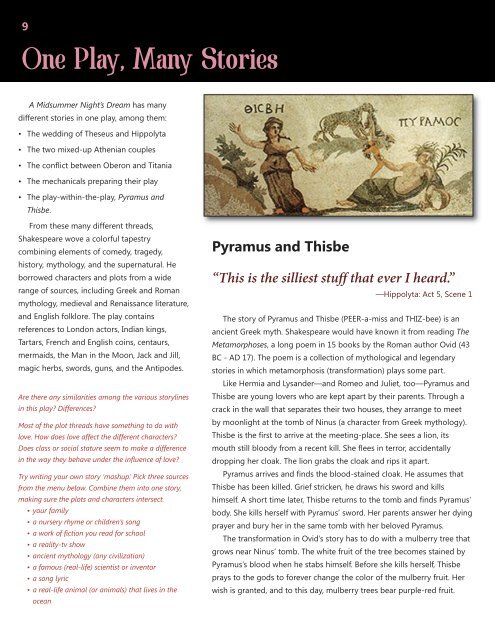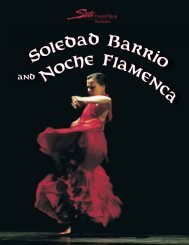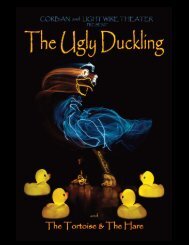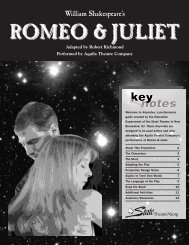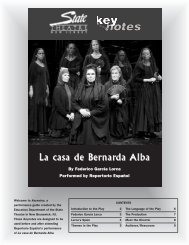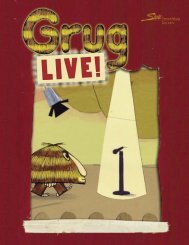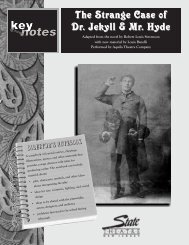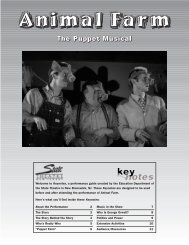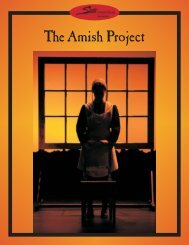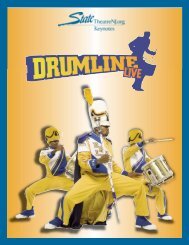A Midsummer Night's Dream - State Theatre
A Midsummer Night's Dream - State Theatre
A Midsummer Night's Dream - State Theatre
You also want an ePaper? Increase the reach of your titles
YUMPU automatically turns print PDFs into web optimized ePapers that Google loves.
9<br />
One Play, Many Stories<br />
A <strong>Midsummer</strong> Night’s <strong>Dream</strong> has many<br />
different stories in one play, among them:<br />
• The wedding of Theseus and Hippolyta<br />
• The two mixed-up Athenian couples<br />
• The conflict between Oberon and Titania<br />
• The mechanicals preparing their play<br />
• The play-within-the-play, Pyramus and<br />
Thisbe.<br />
From these many different threads,<br />
Shakespeare wove a colorful tapestry<br />
combining elements of comedy, tragedy,<br />
history, mythology, and the supernatural. He<br />
borrowed characters and plots from a wide<br />
range of sources, including Greek and Roman<br />
mythology, medieval and Renaissance literature,<br />
and English folklore. The play contains<br />
references to London actors, Indian kings,<br />
Tartars, French and English coins, centaurs,<br />
mermaids, the Man in the Moon, Jack and Jill,<br />
magic herbs, swords, guns, and the Antipodes.<br />
Are there any similarities among the various storylines<br />
in this play? Differences?<br />
Most of the plot threads have something to do with<br />
love. How does love affect the different characters?<br />
Does class or social stature seem to make a difference<br />
in the way they be have under the influence of love?<br />
Try writing your own story ‘mashup.’ Pick three sources<br />
from the menu below. Combine them into one story,<br />
making sure the plots and characters intersect.<br />
• your family<br />
• a nursery rhyme or children’s song<br />
• a work of fiction you read for school<br />
• a reality-tv show<br />
• ancient mythology (any civilization)<br />
• a famous (real-life) scientist or inventor<br />
• a song lyric<br />
• a real-life animal (or animals) that lives in the<br />
ocean<br />
Pyramus and Thisbe<br />
“This is the silliest stuff that ever I heard.”<br />
—Hippolyta: Act 5, Scene 1<br />
The story of Pyramus and Thisbe (PEER-a-miss and THIZ-bee) is an<br />
ancient Greek myth. Shakespeare would have known it from reading The<br />
Metamorphoses, a long poem in 15 books by the Roman author Ovid (43<br />
BC - AD 17). The poem is a collection of mythological and legendary<br />
stories in which metamorphosis (transformation) plays some part.<br />
Like Hermia and Lysander—and Romeo and Juliet, too—Pyramus and<br />
Thisbe are young lovers who are kept apart by their parents. Through a<br />
crack in the wall that separates their two houses, they arrange to meet<br />
by moonlight at the tomb of Ninus (a character from Greek mythology).<br />
Thisbe is the first to arrive at the meeting-place. She sees a lion, its<br />
mouth still bloody from a recent kill. She flees in terror, accidentally<br />
dropping her cloak. The lion grabs the cloak and rips it apart.<br />
Pyramus arrives and finds the blood-stained cloak. He assumes that<br />
Thisbe has been killed. Grief stricken, he draws his sword and kills<br />
himself. A short time later, Thisbe returns to the tomb and finds Pyramus’<br />
body. She kills herself with Pyramus’ sword. Her parents answer her dying<br />
prayer and bury her in the same tomb with her beloved Pyramus.<br />
The transformation in Ovid’s story has to do with a mulberry tree that<br />
grows near Ninus’ tomb. The white fruit of the tree becomes stained by<br />
Pyramus’s blood when he stabs himself. Before she kills herself, Thisbe<br />
prays to the gods to forever change the color of the mulberry fruit. Her<br />
wish is granted, and to this day, mulberry trees bear purple-red fruit.


